China Cycling Travelogues
Do you have a China cycling travelogue you would like
to share here?
Contact us for details.
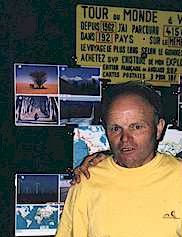
Guinness Book of Records holder
"Epic Journeys"
Around the World by Bicycle - Part 4
Copyright © Heinz Stücke, 2000.
Korea, Taiwan, the Philippines and Hong Kong were the first few places I visited after Japan; and exciting and beautiful places they were. Hong Kong rivals Rio de Janeiro in beauty and spectacular setting. In Taiwan Chinese culture was kept at its best. The great cultural heritage of the Chinese people is on view in the National Palace Museum. The people are busy and hard working. My attempt to visit the People's Republic of China in 1972 was not successful.
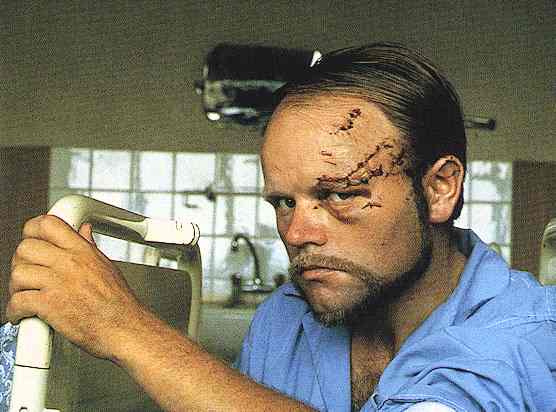
Next I went to the Philippines. The people there were constantly smiling and friendly and carefree. Everywhere I cycled, laughing and unusually pretty children would follow me out of curiosity. 350 years of Spanish colonisation and 50 years of American rule left them with much Western influence. Everybody speaks English with ease. Here I saw the World famous rice terraces of Banawe, Bontoc and other places in northern Luzon. It took many centuries for skilful mountain people to build them. Further south lies the perfectly even cone of active Mayon Volcano.
A Swedish cargo vessel took me to Australia, my last continent. It was clear from the beginning that it would require some time to make the tour around Australia. I did not plan from the L start to make the tour so extensive, but people kept asking me, "Will you go to Darwin," or, "Will you cross the Nullabor?" Often they expressed doubts about not being able to do it, "I bet you can't cross the Nullabor by bicycle". To go west of Ayers Rock? "Nobody has done it (by bicycle) and you must be crazy if you try it." "It's not a question of whether I'll be able to do it," I would answer, "It's only a matter of having time to prepare for it in a proper way, of using good sense and of getting up and going!" I kept going for just under 7 months and covered 12,000 kms.
In the outback areas many motorists would stop to offer water (or a cold beer) or to invite me to visit them, or just to see the guy who wants to make his life so hard. In the cities I stayed with the people I met in the outback, Repeatedly I came across the same people in different parts of the country. Each time there was great "Hellos" and each time people were surprised about the distance I had covered.
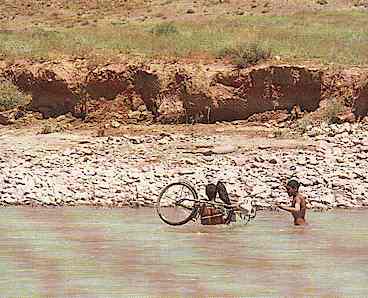
When thinking about the country I never forget the great 'Red Centre" of Australia with strnge landscapes and impressive rocks and gorges. When it rains, wild flowers cover the land as if they were a carpet. Out of all the coastal regions the area round Port Cambell in Victoria is my favourite spot. The ocean has cut the coast into amazing shapes. I was taken to some of the sights by the Cowells of Nobel Park. They became an Australian counterpart to the Kirbys of Alabama.
But the real challenge in Australia was the 1,300 km sandy trail, lying west of Ayers Rock. Vehicles travel infrequently on this often corrugated narrow trail. My bike was loaded up with food and water. Riding from sunrise to sunset I could cover a maximum of 80 kms a day (all in first gear). Part of the way I went through aboriginal reserve. People at two outback stations knew of my expedition and were helpful. I was told about water holes and twice water was placed for my consumption in "easy to spot" places.
When the day grew old and the mood of the sky would change, my own mood would change too. Can the horizon not be reached? Am I homesick? Home to where? Is it just emotions that people have? The sky becomes dramatic, the feeling is good. Let me have a last check on the map. Where will I put my head down for the night? The map is blank, but anyway I like to know where I am. A campsite is chosen. The sinking sun turns a hill into a glowing red colour. Nobody is around and everything is completely still.
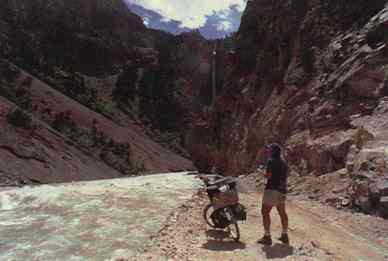
If Australia's vast distances were challenging, New Zealand's varied countryside was much easier and much more pleasant. New Zealand is really the ideal country to cycle in. The climate has few extremes, the distances are short and the traffic is light. In the south the glaciers, the fjords and the high mountains with snow all the year round are the major attractions, while in the north it's the area of volcanic activity and the Maori cultural places (original settlers of New Zealand) that most people want to see.
Plenty of palmtrees, plenty of beaches, plenty of sunshine is fine for a while but too much of it is not,and soon you have enough of it. This became, true to some extent on a number of South Pacific islands after I visited New Zealand. Fiji, Tonga. Samoa, New Caledonia, Vanuatu, the Solomons, Papua-New Guinea etc. are exotic names indeed and of course worth seeing. I bought a stopover air ticket and this was important, because the immigration authorities kept asking for onward tickets.
One of my difficulties came on the day when I was on board the SS Ainiu back to Fiji and the Captain informed me that my passport had been lost and the Fiji Immigration Officer didn't want to let me off the ship. There was no German representative in Fiji and it took five weeks of corresponding back and forth to Australia until a new passport arrived from the German Embassy in Canberra.
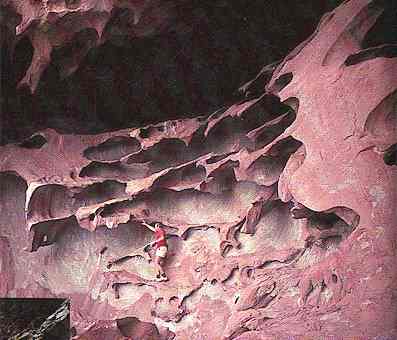
The tropical climate on the islands is not always healthy either.Tropical ulcers and sores develop from the smallest scratch. Food may be scarce and tasteless. Road conditions can be very bad. A road on Bogainville island turned into 3 feet of grass with vines and undergrowth which left me desperate and helpless. Melanesian and Polynesian people live mostly on the islands and a large group of immigrant Indians in Fiji. The people on Bogainville are very black. Phrases like: "blacker than black", or "the blackest people in the world", I heard people call themselves without any superiority or inferiority complex.
Most of the places I mentioned have an English colonial past and became independent only recently. New Caledonia is French however and Vanuatu was the New Hebrides where a joint English-French rule was exercised; it was the only 'so called' Condominium Government in the world. Everything was in duplicate from the two Governors to the postal system, the police force and the flags.
Papua-New Guinea is a country of great contrast. A country of high mountains and of deep jungles and of strange people and even stranger customs. Here people are very much attached to nature and to a tribal way of life that hasn't changed much. But the Australian Government and missionaries did bring some western culture to the area along with western goods. As a result you may see contrasting, even grotesque sights, such as a naked native buying food in an air-conditioned supermarket in Mount Hagen in the highlands. Very impressive affairs are so called sing-sings when the native people gather and everything is tribal and strange, and here the Westerner will certainly feel out of place.
After I arrived in Indonesia I unfortunately had problems with my stomach. For 3 months cycling around I suffered with some kind of dysentry. At the same time road conditions in the remoter islands of Timor, Flores, Sumbawa were among the worst I ever came across. In the heat of the midday sun I would collapse in the shade somewhere and didn't feel the urge of ever getting up again. Bali was not quite the paradise people like to make it, but still one of the great beautiful places one has to see.
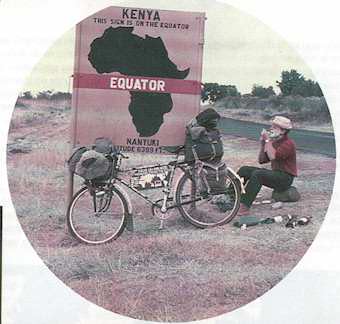
Despite my condition I climbed 'Bromo' and 'Merapi' volcanos in Java, and after staying in Singapore for a month I was ready and well to start off for Bangkok up through the Malay peninsula. There the communist advance in Vietnam and the occurrences in Cambodia made people very tense. I could not go to Vietnam or Cambodia anymore. I did cycle to Luang Prabang in Laos. I was afraid of running into military operations but the people and the soldiers I encountered did not bother me.
On the way to Calcutta from Bangkok I stopped the 7 days permitted in Burma and joined what travellers called "The Great Burma Race". Due to the visa restrictions you are only permitted seven days. To see as much as possible you have to run! India in 1975/76 was not all that much different from the India of 1961 which I remembered vividly. If anything, there seemed to be even more people now. The state of emergency imposed on India by Mrs. Gandhi did seem to make things work better and basic foods were available at controlled prices.
The people were as curious as ever. Repetitious questions drove me crazy sometimes. I selected remoter areas of India to cycle in Kashmir, Ladakh and Himalchal-Pradesh for the summer months, trekking in Nepal in October/November and Assam, Meghalaya, Tripura and Rajastan in winter.
Most memorable was the tour across high Himalayan mountains 474 km from Leh to Manali pushing my bicycle to a record height of 5,360 m and of course it was a great experience to walk to the foot of Mount Everest in Nepal. From New Delhi in Spring of 1976 I started my long trek westwards, homewards, towards Europe once more. In Afghanistan I took the difficult central route via Band-i-Amir and Chakcharan to Herat and I tried Turkey's cold East-Anatolian Region in the middle of winter, just to prove that this is possible, regardless of what any one says. It was a very special day when I crossed the Bosphorous and stepped back onto European soil on 4 January 1977, 14 years exactly to the day when I left via Gibraltar in 1963. The ferry took me across the Bosphorous passing the Dolmabahce palace on the European side and immediately I felt myself coming nearer the bustle and sound of Istanbul, the minarets, the end of the day with the sun big and red behind Aya Sophia. At the time I thought "I'll have to get accustomed again to Europe". Then, "Maybe I should do a tour of Europe first before going home"..
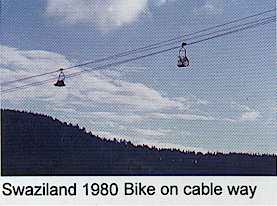
And that is exactly what happened almost as if I was afraid of going home, as if I never wanted to stop or abandon this life of travelling and of freedom. Cautiously I approached the borders of my homeland in Austria- in Switzerland- in France and Holland during 1977 without ever setting foot across the border. Money was low. I wasn't going home with my hands empty. Only about 200 km away from my home-town my aging father and my sisters and their expanding families came to visit me during a weekend in Holland. Yes, only a weekend. After all they had to work like everybody else. This suddenly made it clear to me that I wasn't going to stop. There were so many countries not yet seen. In my head new long-range plans began to form. I went to England and spent a couple of Winter months in London. I sold my story to various journals and engaged the help of an agent. Then I made a lengthy tour of the U.K. and Ireland and Iceland.
The Winter of 1978 was approaching. I took the map of Africa. This great Continent of over 50 independent states I had barely touched on my 1963-64 tour. I wanted to cross the Sahara from North to South, after all a new tarmac road had already been built to Tamanrasset in the heart of the Sahara. Soon it would be too easy to do. Martin Eaves the Englishman I had first met in Assam, India, wanted to do the same. We prepared together in his home near Bristol. I needed a visa for Algeria. I applied early but the OK from Algiers never came.
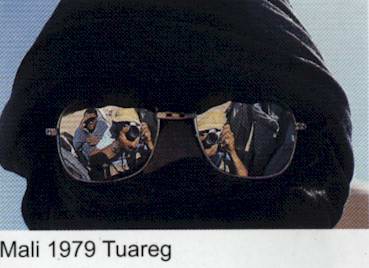
We started together loaded up with extras for the desert and split again in Paris while I tried once more for the visa. I saw Martin only once more in Cameroon. I never obtained the visa, changed plans quickly and took a cargo vessel from Marseille to Dakar-Senegal. I didn't know exactly what my route would be, or how long I would stay. A new idea had become important to me, the idea: "To see all the countries in the world." My route was determined by countries "Not seen." Because countries "Not seen" in Africa were spread all over the continent the travels there extended to three years and at the end of that time there were still some missing. Almost all was done by bicycle (40,000 kin). I had more adventures to overcome, although with advancing age and growing expenence I tended to do things with more preparation and caution, eliminating adventures of the sort that come when you are young and enthusiastic but inexperienced. Today I call it: "Doing stupid things" like entering the desert without sufficient water hoping some help will come along when you need it. Surprisingly often it does. For me the danger comes by doing more difficult routes, routes away from civilisation, routes where few vehicles go. I crossed areas and reached countries that were difficult to do even in the Eighties. The jungles of Gabon or Zaire for example, or the Kalahari Desert or Timbuktou. I cycled in Madagascar for 90 days and in La Reunion saw a new volcano erupting and growing.
Surprisingly a visa was granted for Saudi Arabia and I cycled the length of the country. Saudi Airline Magazine published a story about my tour that they received from my agent in London. A lavish press conference was given in the Sheraton Hotel in Yeddah, even though tourists are not allowed in Saudi Arabia.
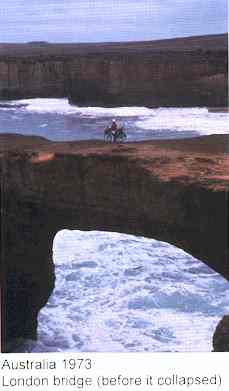
I thought about the good time I had in Ethiopia during my 1963 tour there and how quickly the situation can change. This time I was on the other side of the border in Somalia. Ethiopia had become difficult to enter. I saw the many refugee camps near the border. Somalia itself was not exactly easy to enter either, nor well known, photo taking was restricted but the people were friendly.
Less of a happy occasion was the night in Nigeria when at last, after all those years on the road and in the bush, I stepped, barefoot on a scorpion, and was stung. In Cameroon I was detained for 6 days after a discussion with State Security Police. I was accused of "Slandering The State." It didn't help that my visa had just expired. I was finally freed through the energetic help of the German Consul in Duala.
Looking back and thinking about it the most dangerous moment probably came in Zambia when four of Nkomos "Freedom Fighters" stopped me on the road near Rufunsa 155 km East of Lusaka. One of them pointed his AK47 in my direction and pulled the trigger. The bullet went through the big toe on my right foot. I didn't feel any pain. They ripped my things apart and stripped me to my underpants, threatening to shoot me all the while. Luckily only a little later a German working for the Zambian Government passed in his car and heard me shouting "I am a tourist, the German Embassy please". He grasped the situation at once, but sped away because the "Freedom Fighters" pointed their guns at his car. His wife and children were in the car too. But he soon came back and with five Zambian policemen. The "Freedom Fighters" said I was a military man from Zimbabwe (just independent). The police said they would check it. After first aid on my foot, my things were much looked at. It became clear that I was only a world cyclist after all. Mr. Buttner my rescuer took me to Lusaka and I spent ten days recuperating in his beautiful home.
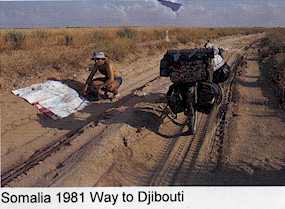
In 1982 I returned to Europe for the second time. In a "mopping up" operation I picked the countries not yet seen. Malta-Monaco-Poland-Romania-Bulgaria transiting others on the way. I chose the Eastern-Block countries in the middle of the Winter 82-83 to make an otherwise "Too easy" journey worthwhile, and to prove that you can do it, if you wish to. Even camping in snow and ice. My agent had provided me with some extra money, because the Eastern-Block countries became expensive since one was obliged to exchange a minimum in foreign currencies (Poland 15$US, CSSR 12$US, Romania 10$US per day).
In 1983 I came to Spain. For one year I travelled the Iberian peninsula and successfully sold another brochure of my journey.
Failing to find an economical flight to the Caribbean, I found myself once more in Africa. Mauritania received me with high temperatures never known before. Near Choum and Atar the thermometer climbed to +530C (in the shade of course!).
More hardship was to come. In Gambia angry bees stung me 40 to 60 times and left me in hospital for 4 days and with a memory forever to watch out for angry bees, not that I will forget the Tse-Tse flies in Guinea. Their bites were beastly too. I had food poisoning in Dakar and in draught prone Cape-Verde Islands the rain of the century fell (400 mm in 48 hrs.). The resulting floods tore down what people had laboured hard to build over the years. 32 people died. My tent which was built on a 1,400 m high ridge was torn in the storm. I found refuge in a mountain cabin.
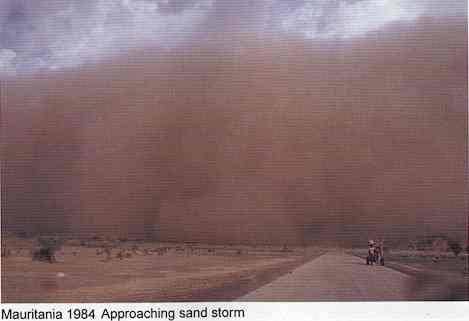
Finally I did the much dreamed of trans Sahara crossing (May-June 85). This seemed almost easy compared to the earlier difficulties. In 15 days I had crossed 600 km of the worst stretch between Arlit and Tamanrasset. It took 57 days from Agadez to the shores of the Mediterranean. Food and water was freely given by passing truck drivers and tourists in vehicles.
September 1985 saw me once more in London. Within days I had gone to the Caribbean region hopping from one island state to another first by cargo boat then by aircraft. Most island states were expensive. The Dominican Republic I liked the best. Large, Spanish speaking, cheap, few tourists, pretty girls. I spent two months there. In early 1987 all countries of the "Western Hemisphere" were visited.
From Miami a US$87 "special offer" flight by "Virgin Atlantic" brought me back to London in 9 hours. The flight included steak, free drinks and a box for my bicycle. This must have been one of the cheapest flights an airline has ever offered. For a few weeks I got stuck in the office of F. Spooner Pictures sifting through a growing mountain of pictures and papers. Not wanting to be buried in it I soon escaped from the accumulations of the past and set my sights on China. This grand country I had not been able to enter in 1972. Although flights can bring you to the most remote corners of the earth in a matter of hours, I took my time picking a few countries on the way.
Sri Lanka where I stopped first was a bargain - the Maldives are exotic and beautiful - Sumatra was remote and mountainous - Sarawak and Sabah full of jungle and Brunei is owned by a Sultan who is thought to be the richest man in the world.
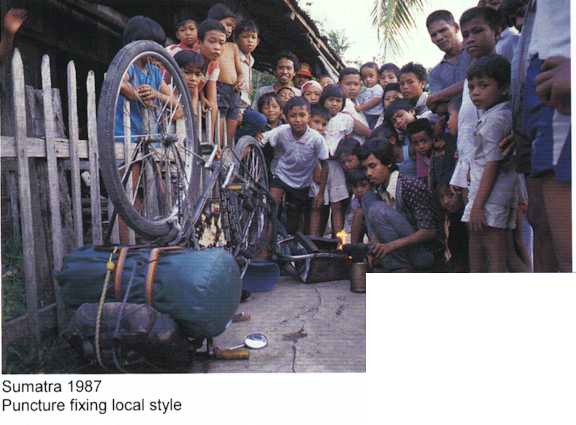
Skip to: Heinz Stücke Page 1 | Heinz Stücke - Page 2 | Heinz Stücke - Page 3 | Heinz Stücke - Page 4 | Heinz Stücke - Page 5
Bike China Adventures
Main Page | Guided Tours
| Photos | Bicycle Travelogues
| Products | Info |
Contact Us
Copyright © Bike China Adventures, 1998-2005. All rights reserved.